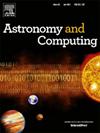SAS in ESA Datalabs: A new platform for XMM-Newton analysis
IF 1.8
4区 物理与天体物理
Q2 ASTRONOMY & ASTROPHYSICS
引用次数: 0
Abstract
XMM-Newton is a cornerstone mission of the European Space Agency (ESA) for X-ray astronomy, providing high-quality X-ray data for astrophysical research since the start of the century. Its Science Analysis System (SAS) has been a reliable data reduction and analysis software, evolving throughout the years to meet changing user needs, while incorporating new methods. This paper presents the XMM-SAS Datalab, a tool within the cloud-based ESA Datalabs platform, designed to enhance the interactivity and collaborative potential of SAS. By integrating SAS with a modern, Python-based JupyterLab interface, it enables shared analysis workspaces, removes the need for local software setup, and provides faster access through containerised environments and preconfigured libraries. Moving SAS to the cloud preserves a consistent software setup while eliminating installation complexities, saving time and effort. A case study of the X-ray binary Vela X-1 demonstrates that the Datalabs platform reliably replicates local SAS outputs, with minimal deviations attributed to calibration file versions. The XMM-SAS Datalab allows straightforward X-ray data analysis with collaborative process, setting the way for future adaptations in e-science platforms and multi-wavelength astronomy, while offering traceability and reproducibility of scientific results.
ESA数据库中的SAS: XMM-Newton分析的新平台
xmm -牛顿是欧洲航天局(ESA) x射线天文学的基石任务,自本世纪初以来为天体物理学研究提供高质量的x射线数据。其科学分析系统(SAS)一直是可靠的数据减少和分析软件,多年来不断发展,以满足不断变化的用户需求,同时纳入新的方法。本文介绍了XMM-SAS数据实验室,这是基于云的ESA数据实验室平台中的一个工具,旨在增强SAS的交互性和协作潜力。通过将SAS与基于python的现代JupyterLab接口集成,它可以实现共享分析工作区,消除对本地软件设置的需求,并通过容器化环境和预配置库提供更快的访问。将SAS迁移到云端保留了一致的软件设置,同时消除了安装复杂性,节省了时间和精力。对x射线双星Vela X-1的案例研究表明,Datalabs平台可靠地复制了本地SAS输出,校准文件版本的偏差最小。XMM-SAS Datalab可以通过协作过程进行直接的x射线数据分析,为电子科学平台和多波长天文学的未来适应铺平道路,同时提供科学结果的可追溯性和可重复性。
本文章由计算机程序翻译,如有差异,请以英文原文为准。
求助全文
约1分钟内获得全文
求助全文
来源期刊

Astronomy and Computing
ASTRONOMY & ASTROPHYSICSCOMPUTER SCIENCE,-COMPUTER SCIENCE, INTERDISCIPLINARY APPLICATIONS
CiteScore
4.10
自引率
8.00%
发文量
67
期刊介绍:
Astronomy and Computing is a peer-reviewed journal that focuses on the broad area between astronomy, computer science and information technology. The journal aims to publish the work of scientists and (software) engineers in all aspects of astronomical computing, including the collection, analysis, reduction, visualisation, preservation and dissemination of data, and the development of astronomical software and simulations. The journal covers applications for academic computer science techniques to astronomy, as well as novel applications of information technologies within astronomy.
 求助内容:
求助内容: 应助结果提醒方式:
应助结果提醒方式:


